Salt marshes in the Wadden Sea show growth but challenges remain say experts

The latest Wadden Sea Quality Status Report (QSR) on Salt Marshes, released by the Trilateral Wadden Sea Cooperation, reveals notable expansion of salt marshes, especially in barrier-connected island and foreland-type salt marshes. Wadden Sea salt marshes now cover over 42,000 hectares, divided over five distinct types. This accounts for approximately 20% of Europe’s coastal salt marshes. Despite these positive developments, the report also highlights ongoing challenges in maintaining the health of this vital ecosystem.
Lead authors Dr. Kelly Elschot from Wageningen University and Research and Dr. Peter Esselink from PUCCIMAR emphasise the significance of these changes. “We’ve seen a substantial increase in salt marsh areas, with around 6,000 hectares added in the past two decades. But it is important to discriminate between the different marsh types. The increase is mainly found in the back-barrier marshes and mainland marshes, while Hallig marshes remain constant over time” Elschot and Esselink explained. “While expansion is a good sign, we need to focus on restoring natural dynamics, especially in man-made marshes.”
One of the targets of the Wadden Sea Plan is to transform artificial salt marshes into more natural states. Projects in Lower Saxony, for example, are reintroducing natural processes in areas that had been heavily modified by human intervention. However, balancing the benefits of engineered salt marshes with the need for natural development stages remains a challenge. “The creation of salt marshes for coastal protection is important, but we must ensure that it doesn’t prevent the natural processes that these ecosystems depend on,” added Elschot and Esselink.
The mainly artificial foreland-type marshes account for 57% of the total and rise at an average rate of 8.7 mm per year, far outpacing the 2.0-3.0 mm annual rise in Mean High Tide (MHT). Concerning the relationship between salt marshes and sea-level rise, Hallig salt marshes are particularly vulnerable, with surface elevation increases of just 1.6 mm per year, respectively, lagging behind the MHT increase.
The Wadden Sea Quality Status Report is a conglomeration of thematic reports reflecting the continuous monitoring and evaluation of the ecological status of the Wadden Sea. Openly accessible at qsr.waddensea-worldheritage.org, it forms the baseline for the identification and review of new emerging challenges. As part of the Trilateral Monitoring and Assessment Programme, the QSR helps identify and fill knowledge gaps and priorities for the improvement of the ecological status of the Wadden Sea. The compiled information feed into the agreements of the Trilateral Cooperation.
